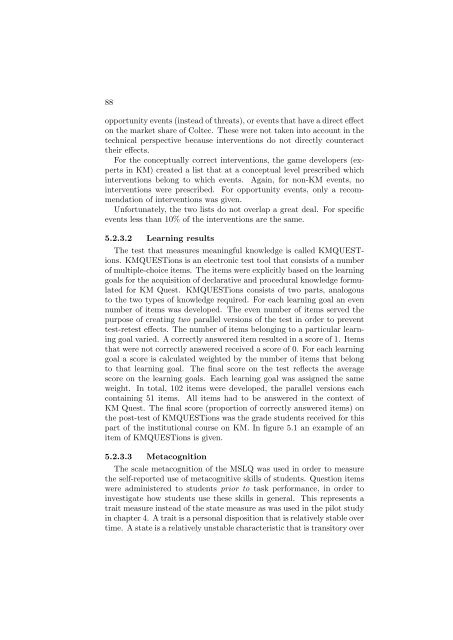The role of metacognitive skills in learning to solve problems
The role of metacognitive skills in learning to solve problems
The role of metacognitive skills in learning to solve problems
You also want an ePaper? Increase the reach of your titles
YUMPU automatically turns print PDFs into web optimized ePapers that Google loves.
88<br />
opportunity events (<strong>in</strong>stead <strong>of</strong> threats), or events that have a direct effect<br />
on the market share <strong>of</strong> Coltec. <strong>The</strong>se were not taken <strong>in</strong><strong>to</strong> account <strong>in</strong> the<br />
technical perspective because <strong>in</strong>terventions do not directly counteract<br />
their effects.<br />
For the conceptually correct <strong>in</strong>terventions, the game developers (experts<br />
<strong>in</strong> KM) created a list that at a conceptual level prescribed which<br />
<strong>in</strong>terventions belong <strong>to</strong> which events. Aga<strong>in</strong>, for non-KM events, no<br />
<strong>in</strong>terventions were prescribed. For opportunity events, only a recommendation<br />
<strong>of</strong> <strong>in</strong>terventions was given.<br />
Unfortunately, the two lists do not overlap a great deal. For specific<br />
events less than 10% <strong>of</strong> the <strong>in</strong>terventions are the same.<br />
5.2.3.2 Learn<strong>in</strong>g results<br />
<strong>The</strong> test that measures mean<strong>in</strong>gful knowledge is called KMQUESTions.<br />
KMQUESTions is an electronic test <strong>to</strong>ol that consists <strong>of</strong> a number<br />
<strong>of</strong> multiple-choice items. <strong>The</strong> items were explicitly based on the learn<strong>in</strong>g<br />
goals for the acquisition <strong>of</strong> declarative and procedural knowledge formulated<br />
for KM Quest. KMQUESTions consists <strong>of</strong> two parts, analogous<br />
<strong>to</strong> the two types <strong>of</strong> knowledge required. For each learn<strong>in</strong>g goal an even<br />
number <strong>of</strong> items was developed. <strong>The</strong> even number <strong>of</strong> items served the<br />
purpose <strong>of</strong> creat<strong>in</strong>g two parallel versions <strong>of</strong> the test <strong>in</strong> order <strong>to</strong> prevent<br />
test-retest effects. <strong>The</strong> number <strong>of</strong> items belong<strong>in</strong>g <strong>to</strong> a particular learn<strong>in</strong>g<br />
goal varied. A correctly answered item resulted <strong>in</strong> a score <strong>of</strong> 1. Items<br />
that were not correctly answered received a score <strong>of</strong> 0. For each learn<strong>in</strong>g<br />
goal a score is calculated weighted by the number <strong>of</strong> items that belong<br />
<strong>to</strong> that learn<strong>in</strong>g goal. <strong>The</strong> f<strong>in</strong>al score on the test reflects the average<br />
score on the learn<strong>in</strong>g goals. Each learn<strong>in</strong>g goal was assigned the same<br />
weight. In <strong>to</strong>tal, 102 items were developed, the parallel versions each<br />
conta<strong>in</strong><strong>in</strong>g 51 items. All items had <strong>to</strong> be answered <strong>in</strong> the context <strong>of</strong><br />
KM Quest. <strong>The</strong> f<strong>in</strong>al score (proportion <strong>of</strong> correctly answered items) on<br />
the post-test <strong>of</strong> KMQUESTions was the grade students received for this<br />
part <strong>of</strong> the <strong>in</strong>stitutional course on KM. In figure 5.1 an example <strong>of</strong> an<br />
item <strong>of</strong> KMQUESTions is given.<br />
5.2.3.3 Metacognition<br />
<strong>The</strong> scale metacognition <strong>of</strong> the MSLQ was used <strong>in</strong> order <strong>to</strong> measure<br />
the self-reported use <strong>of</strong> <strong>metacognitive</strong> <strong>skills</strong> <strong>of</strong> students. Question items<br />
were adm<strong>in</strong>istered <strong>to</strong> students prior <strong>to</strong> task performance, <strong>in</strong> order <strong>to</strong><br />
<strong>in</strong>vestigate how students use these <strong>skills</strong> <strong>in</strong> general. This represents a<br />
trait measure <strong>in</strong>stead <strong>of</strong> the state measure as was used <strong>in</strong> the pilot study<br />
<strong>in</strong> chapter 4. A trait is a personal disposition that is relatively stable over<br />
time. A state is a relatively unstable characteristic that is transi<strong>to</strong>ry over
















